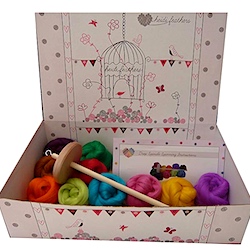We're aiming to wash and rinse out the dirt and lanolin from the raw fleece without felting it. Therefore agitation has to be kept to a minimum. I like using these net bags (available from your dry-cleaning or pound store) as they make it easier and cleaner to handle the fleece and help you to handle the fleece without rubbing the fibres together too much. Don't pack too much in a bag - the water needs to flow through the fibre.
Carefully place those bags in the hot soapy water. The raw fleece can handle hot water as long as you don't move it around too much and don't transfer it to water of a different temperature. The new product says 20ml per 10litres (that's 2 gallons or one big bucketful). So for my bathful I calculated 80ml, about the same quantity that I'd have used of Power Scour. I would normally leave to soak for 20 mins, but this product says 'paddle after 5 mins'. I'm not quite sure what that means but the aim is to allow the water to flow around the fibre and carry out the dirt, without allowing the fibres to rub together.
I call this 'sheep soup'. It's amazing what dirt is trapped in the fleece. After this first wash, the instructions suggest using the spin cycle or gently squeeze to take out the dirty water before rinsing. I would generally be more cautious and simply leave to drain on a rack for a few minutes rather than spin or squeeze. These bags then needed two changes of rinse water before the water was running clear. I do use the spin cycle (slow spin) to take out most of the water, with the fleece still in the net bags.
Evaluation of the new Fibre Scour
The essential oils (Tea Tree and Lemon Myrtle - antibacterial) smell very strong but pleasant. I assume that the product contains enough of these to be effective rather than just a token amount.At suggested concentration, the new product has cleaned the grease more effectively than I expected. Usually I wash only once in order to take out the dirt and some of the grease leaving a little of the lanolin on the fibres which aids combing and spinning. Now that this fibre has dried (it takes a couple of days to be completely dry) it feels much drier (ie free of grease) than I'd expect. In future I think I will try using a little less product.
[UPDATE] I now have these items (500ml bottles) available at http://handspinner.co.uk/scour_wash_rinse.html























